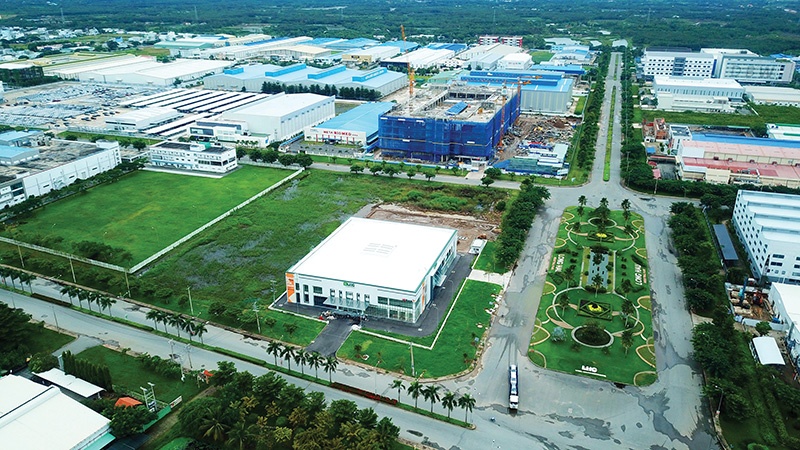Inland container depots bringing profound change to Vietnamese logistics industry
 |
| Logistics associations say that a change of mindset may be required to make the most of inland port connectivity, Photo: Le Toan |
T&T Group has revealed its plan to build the largest inland container depot (ICD) in Vietnam. T&T introduced the Vinh Phuc ICD just 60km away from Hanoi, following close cooperation with YCH Group, a logistics enterprise from Singapore
The Vinh Phuc ICD, which is believed to bring Vietnam closer to its goal of becoming a regional supply chain hub, will cost roughly $200 million.
The port is said to have geographical advantages through its proximity to around 20 industrial zones (IZs) and domestic ports, Noi Bai international airport, and border gates with China and Laos.
These factors allow the Vinh Phuc ICD to serve as the supply chain service centre of domestic enterprises in the northern provinces, promising to handle about 10 per cent of their total volume of containerised goods.
T&T and YCH’s investments are driven by the design of the International Finance Corporation (IFC). In the next 12 months, IFC will present the design of Vinh Phuc ICD, with international social and environmental standards, ensuring the ability to attract funding from foreign investors.
IFC’s experience and advice “will help the T&T and YCH consortium access international finance,” said Do Quang Hien, chairman and CEO of T&T Group last week.
“These links will speed up the progress and put the project into operation sooner, contributing to reducing the cost of logistics services in Vietnam, which is currently accounting for 21 per cent of GDP, compared with less than 10 per cent in more developed markets elsewhere,” Hien added.
Up to now, the Ministry of Transport has licensed 10 inland ports in the north and south of the country. The central region has no ICD currently in the works.
The logistics industry is in a profound transformation as Vietnam needs more modern and large-scale ICDs to ensure that export growth in the next year is always higher than in the previous year.
However, Tran Do Liem, president of the Vietnam Inland Waterways Administration, said, “ICD investments must be calculated very carefully. Also, when developing such a project of any size, location is the most crucial factor.”
According to Liem, an effective ICD must be located between the seaport and the source area, including production centres and IZs.
“The Mekong Delta region has three inland ports, but only Tan Cang’s ICDs operates effectively. Can Tho and Chau Thoi’s have not been able to develop because they are located too deep in the area and badly connected,” Liem explained.
Location is also determining the competitiveness of ICDs. For instance, Haiphong’s road connections do not bring as many business opportunities for ICDs as the railroad connection that them in Lao Cai and Tien Son can utilise or the river connection that Phuc Loc ICD boasts.
In those regions, many manufacturers import and export directly, without going through intermediate ports.
The southern key economic provinces are choosing a different approach. Most ICDs in there are attached to industrial zones and often just 20-70km from seaports, thus supporting these in transhipment of import and export goods by containers. For example, Cai Mep Port receives 80-85 per cent of its exported goods from ICDs through the connected river system.
“They are important in reducing transportation costs and staying ahead of schedule at seaports in Vietnam,” Liem commented.
According to the master plan on the development of Vietnam’s seaport system in the next 10 years, the inland port system will be formed in most of the provinces and cities in the country, especially those located along international routes and key economic corridors.
Le Duy Hiep, chairman of the Vietnam Association of Logistics Service Enterprises said, “While developing a system of inland ports, a change in thinking about connectivity is necessary. In addition to financial and resource investments, a more suitable interconnected network of roads, railway, and waterways must be planned.”
Freight rates are under great pressure because gasoline prices are high, while inland waterway freight rates are only a third of the price of road transport.
“The advantages of large volume transportation of inland waterway transport should not be ignored, as we have 272 inland waterway ports and 42,000km of estuaries capable of developing waterway transport,” Hiep said.
Vietnam possesses geographical advantages, somewhat similar to Singapore, the world’s leading seaport developer. The Singaporean government has played an important role in promoting the development of a comprehensive seaport ecosystem, providing tools for the shipping industry, industrial development, and more, while also applying green and smart port technologies.
Thus, most likely, T&T did not randomly choose a partner from Singapore to develop Vinh Phuc ICD.
What the stars mean:
★ Poor ★ ★ Promising ★★★ Good ★★★★ Very good ★★★★★ Exceptional
Related Contents
Latest News
More News
- Government moves to establish International Financial Centre (December 21, 2025 | 21:00)
- Vietnam's IFC to target global investment flows (December 21, 2025 | 18:00)
- Two national hospitals expand capacity with new facilities (December 20, 2025 | 09:00)
- Ha Tinh breaks ground on major Vingroup industrial and energy projects (December 19, 2025 | 18:24)
- EVN launches major power infrastructure projects nationwide (December 19, 2025 | 18:17)
- VAL inaugurates second production line to meet domestic animal feed demand (December 19, 2025 | 16:37)
- Sun Group pioneers urban tram system in Phu Quoc (December 19, 2025 | 15:00)
- Seven major projects launched to drive Hanoi’s next growth phase (December 19, 2025 | 14:00)
- Securing capital and efficiency for Vietnam’s 2026-2030 growth ambitions (December 17, 2025 | 10:00)
- Vietnam bucking trend in the global M&A landscape (December 16, 2025 | 14:20)

 Tag:
Tag:




















 Mobile Version
Mobile Version